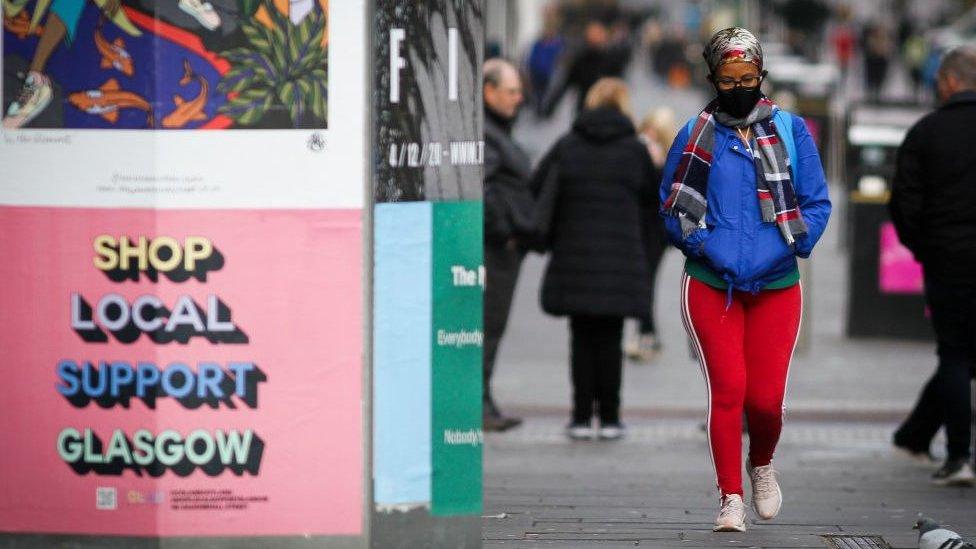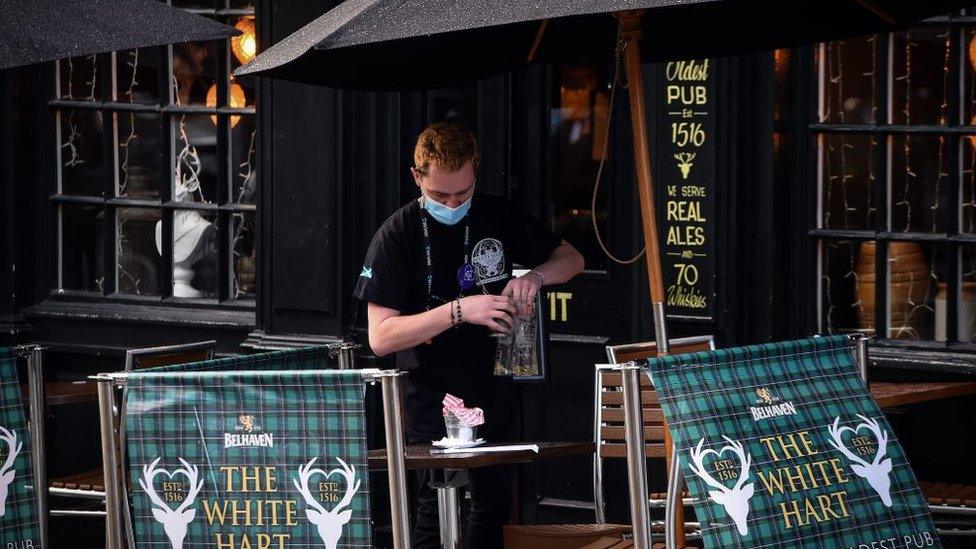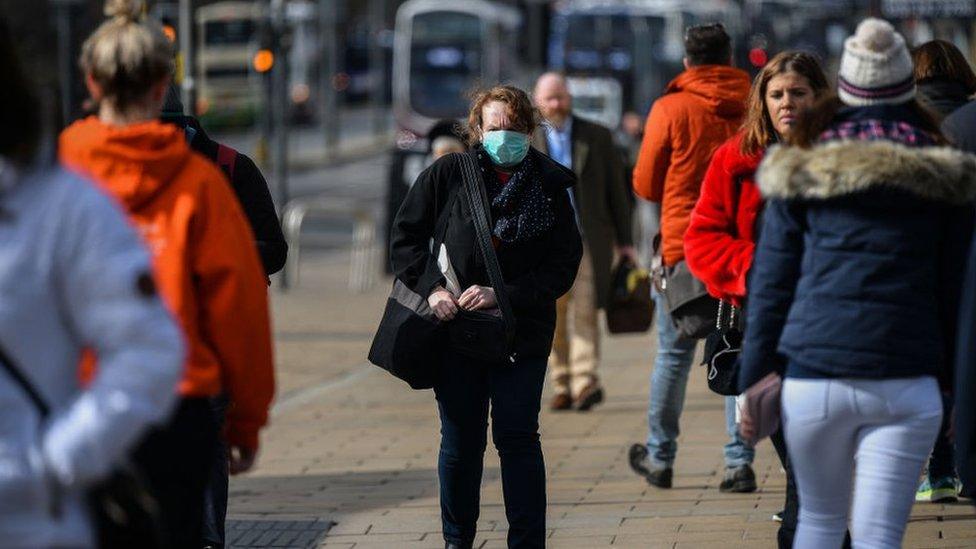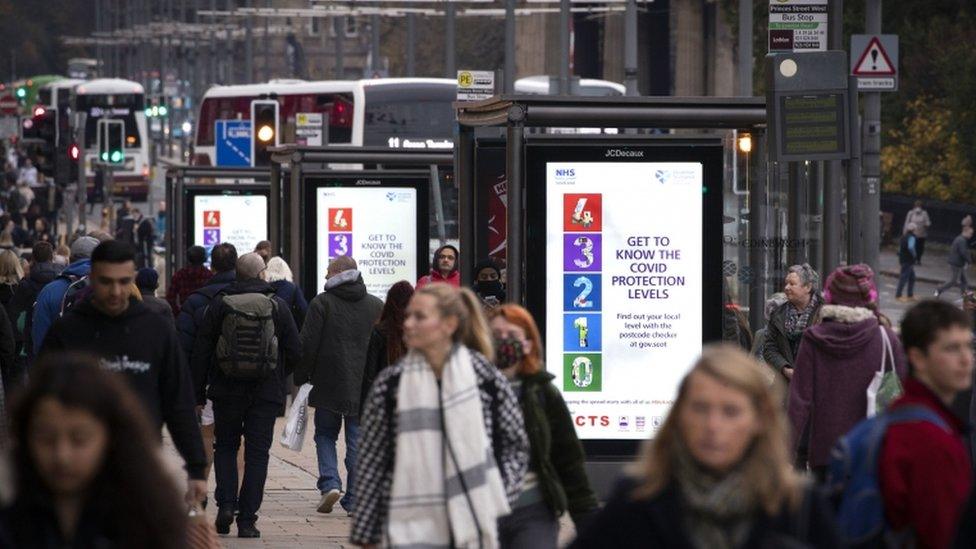Economic visions of pandemic past, present and future
- Published

The Eat Out to Help Out scheme was popular in the summer
The most recent job figures give us some idea of what's going on, but don't show the underlying trends of fewer hours worked, under-employment and lower-paid jobs being shed
While the Scottish employment figures improve and the UK ones worsen, private sector firms are more pessimistic in Scotland, and output last month continued to fall
The trajectory to recovering the pre-pandemic level of output could take 14 months to nearly three years. But don't suppose it will look the same. Your job could have been automated by then.
Woke up this morning, as they say in the best blues songs, having had four visions (some of them embargoed) of the economic consequences of a once-in-a-generation pandemic crisis. I have the best dreams.
The ghost of pandemic past: it took me back to Eat Out to Help Out. Remember those crazy days of summer, when Rishi Sunak was paying half your restaurant tab?
With restaurants busy, vacancies went up. The number seeking jobs in Scotland went down.
We now have the data from the labour force survey carried out by the Office for National Statistics, and they show that headline figure for Scottish unemployment went down by 15,000 to 118,000 over August to October. That's a rate of 4.2%, not far above the low levels being recorded before the pandemic struck.
Meanwhile, across the whole UK, the jobless figure was going sharply up, to 4.9%. Scotland was the best performing nation or region in terms of joblessness, and with the "economically inactive" numbers in decline (generally a good thing) its employment rate was closing the gap on the UK one, just on the other side of 75%.
What does this mean? Well, I'll be honest. I don't know what to make of it. An interpreter of such visions - I have the Fraser of Allander Institute in mind - goes with my hunch that we shouldn't pay too much attention to these numbers.
They don't reflect what we can see happening in the economy more widely: many more Scots turning to unemployment-related welfare benefits than are counted as unemployed; people working fewer hours than they want, though hours have increased a bit; people in jobs well below the ones for which they're qualified.
Above all, lots of people are still on furlough and self-employed income support schemes, who are not looking for work while they have an expectation that the government will keep them just about solvent until the jobs and the work return.
The October U-turn on furlough may have skewed the figures, as employers responded to the rising cost of keeping people on furlough. You'll recall that the policy changed five hours before furlough was due to end, in a chaotic Downing Street weekend, as prime minister and chancellor realised the autumn spike in infections had kiboshed their plans to get back to some sort of normality.
That brings me to my second vision, of something closer to the present. (Apologies to Charles Dickens, by the way.)

The purchasing managers index, external reflects a wide-ranging survey of private sector activity and sentiment. It's more up-to-date than those job numbers and it's comparable across sectors and countries.
That passed its embargo as I slumbered, and showed that private sector output was still declining in November, but not as fast as October. So that's good.
But order intake was down sharply. That's not good. Employers were shedding workers, but at the slowest rate since February. That's not good, but in a less bad way than before.
And the outlook over the next 12 months? That's where Scottish private sector firms - and not for the first time - took a more pessimistic view of their prospects than any other part of the UK, other than Northern Ireland.
Why? I don't know that either. Perhaps they take a different view of the impact of Brexit, or there's a different sectoral mix being reflected. Or could it have something to do with the way Scotland is governed, and its prospects through the May election for Holyrood?
Vaccine hope?
So along came the third vision, of future pandemic. Those Fraser of Allander economists produced their quarterly survey, having raised themselves out of their September misery to point out that the vaccine has given us all a bit of hope for the new year.
We could get back to socialising and working as usual. We could remove the fear of infection. (But in case you've not noticed, don't do any of those things yet - the infection figures across western Europe are getting more alarming.)
What is clear is that the hope of normality by mid-2021 is not going to be matched by the economy. Its recovery will lag the social, work and health recovery.
At the most optimistic scenario, the Allanders say Scotland won't get back to its pre-pandemic level of output until February 2022. The central forecast is for six months after that.
And if there are problems with the vaccine, sustained higher unemployment and businesses going bust, the pessimistic scenario returns to that pre-pandemic output level in September 2023. That's nearly three whole years away.
And will that look anything like normal? Of course it won't. There is scarring to the economy, there are job losses, there is change and churn, and new things starting, much of this happening at a faster rate than usual.

Automation could put hospitality jobs at risk
And that's where my final vision of the further distant future comes in. It appeared in the form of Labour MP Yvette Cooper (sometimes my dreams get a bit unpredictable). She led a review team, looking at the implications of the pandemic for the automation of jobs., external
It doesn't look good. More than six in every 10 jobs currently being furloughed are vulnerable to automation. That was coming anyway, but it's being sped up.
Take restaurants, for instance. It's becoming normal that you clock in your arrival with an app, for public health reasons. That app can then be used to order your food and drink. So there's less need for table service staff.
The rapid shift from conventional retail to online can also get by with fewer staff. ONS figures suggest more than half the 817,000 jobs lost so far this year have been in retail and hospitality.
In the warehouses - sorry, I mean the "fulfilment centres" - from which your online shopping is sourced, the concern about human contact is driving companies to invest in more automated picking and packing.
Ms Cooper says furlough is an opportunity for non-workers to upgrade their skills, and for employers and government to incentivise that.
An interesting figure from that ONS data shows that average earnings have not fallen that much. That probably reflects the fact that lower-paid workers are the ones taking the brunt of the change through this crisis, while higher paid people stay in work and on steady salaries.
As the Fraser of Allander report points out, there are challenges there for governments (plural) to address with their budgets and in their other priorities, to tackle new forms of inequality being exposed and widening.
- Published15 December 2020

- Published15 December 2020

- Published15 December 2020

